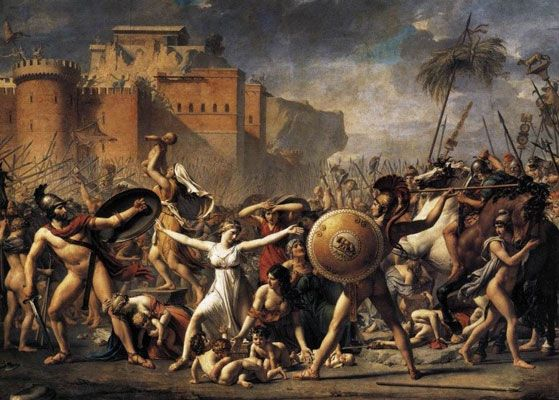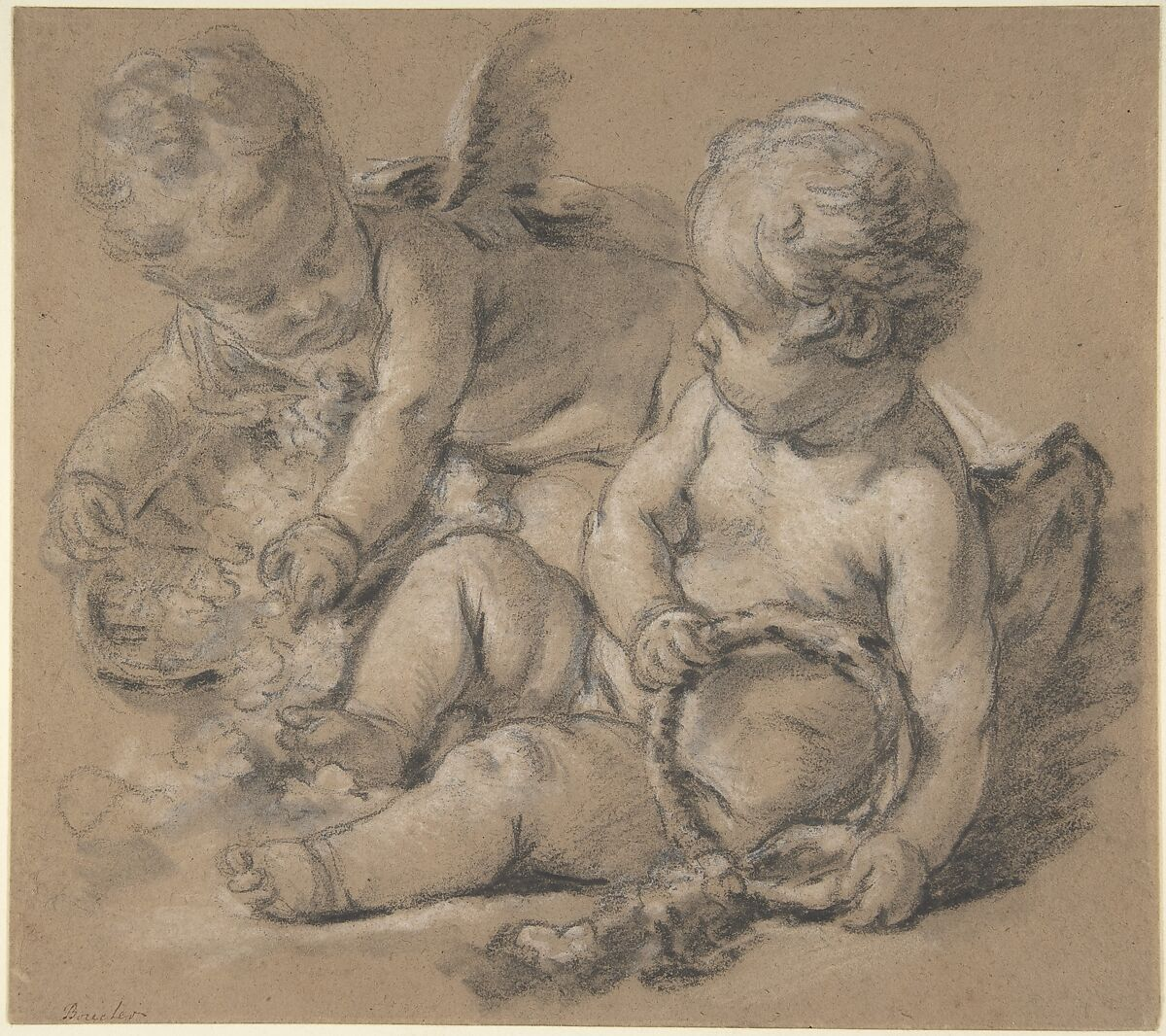Classical
Classical Exhibit
Classical Art in the 1700s
Artist: Jacques-Louis David a French painter in neoclassical style.
Created: 1799
Location: Luxembourg Palace
Location Displayed: Musee du Louvre, Paris
The Intervention of the Sabine Women was painted when Jacques-Louis David was in prison during the French Revolution. The painting depicts men fighting and there are women in between stopping the fight. One lady has her hand against a man holding a sword and another man holding a spear-like tool. You can see the women holding the men pleading to stop the war. There are also babies on the ground at the forefront of the painting. The Sabine Women are pleading for peace during this time.
I chose this portrait because it represents peace. Especially because women are promoting peace in a time when men ruled the world. This picture can still represent this world today, Peace, what we all want. I'm not sure if I would hang this in my house, but I would hang it in my office to remind me of the 'peace' we need to continue daily.
Art Elements:
Texture: This oil painting is on canvas, so the texture is not smooth or soft. If you run your hands over it, the texture is more rough than smooth.
Color: The painting is based on the war that was going on back in the 1700s. So the colors are dark and somewhat gruesome. There are clouds so the sun does not shine directly on the people. It is more of an overcast day rather than a day of sunshine.
Shape: This is a two-dimensional painting. The painting depicts people fighting. The building is two-dimensional as well.
~
A Fisherman Pulling a Net
Artist: Jean Honore Fragonard, French Artist
Created: 1774
Location: Edge of the Bay of Naples
Location Displayed: Metropolitan Museum of Art, New York
Dimensions: 19 3/4 x 14 3/4
The drawing, A Fisherman Pulling a Net, was etched in red chalk. Jean studied in Italy. He also had the rare privilege of working under Pierre-Jacques Onesyme Bergeret de Grancourt He spent some time at the edge of the bay of Naples, where he etched the locals and their wives.
I chose this artwork because it reminds me of my late father. He was a fisherman and I was his deckhand. I started helping my father when I was ten years old. I would fish with him and my uncle. This is where I saw my dad in so much peace, and to this day, I enjoy the same peace drifting on the water fishing. I would own a drawing of this because it reminds me of my late father.
Art Elements:
Texture: This is a chalk drawing, I'm guessing on paper.
Color: The etching is done in red chalk. No other colors. Although it is in red chalk, the shading in different areas of the drawing is smoothed out to create shadows.
Shape: This is a two-dimensional drawing. The drawing depicts a man, a net, and a boat. the portrait of the man is a drawing of the man during the day. The lines depicting the man are soft and subtle. The lighting is soft and not dark.
~
Winged Putti with Flowers
Artist: Francois Boucher (French, Paris 1703-1770 Paris)
Created: ca. 1750
Location: French, Paris
Location Displayed: The Metropolitan Museum of Art, New York
Dimensions: 8 5/16 x 9 1/4
The drawing, Winged Putti with Flowers, was etched in chalk. Francis is a French artist. He was the first appointed painter to the King. He first learned painting and drawing from his father, Nicholas, who was a member of the Academy de Saint-Luc.
I chose this artwork because it reminds me of my two granddaughters. They are Irish twins, eleven months apart. They are toddlers, ages 1 and 2 years old. They are both innocent, just as this drawing depicts two innocent babies. I also really like pictures of cherubs and this drawing reminds me of cherubs. I would own a drawing of this because it reminds me of my granddaughters and I would hang it next to their picture.
Art Elements:
Texture: This is a chalk drawing, I'm guessing on paper.
Color: The etching is done in black and white chalk.
Shape: This is a two-dimensional drawing. The drawing depicts two winged putti. The lines depicting the cupids are soft and subtle. The lighting is soft and not dark. He uses black chalk as the main color scheme and smoothes out in some areas to create a gray shading. He also uses white chalk in different areas to create a soft glow of an angel.
Sources:
Reed Enger, "The Intervention of the Sabine Women," in Obelisk Art History, Published September 25, 2015; last modified October 08, 2022, http://www.arthistoryproject.com/artists/jacques-louis-david/the-intervention-of-the-sabine-women/.
French, J.H.F. (1774) Jean Honoré Fragonard: A fisherman pulling a net, The Metropolitan Museum of Art. Available at: https://www.metmuseum.org/art/collection/search/371766 (Accessed: 18 March 2024).
French, F.B. (no date) François Boucher: Winged putti with flowers, The Metropolitan Museum of Art. Available at: https://www.metmuseum.org/art/collection/search/336356 (Accessed: 18 March 2024).
François Boucher (no date) Artist Info. Available at: https://www.nga.gov/collection/artist-info.996.html (Accessed: 18 March 2024).



Hi Hazel! I thought your first piece, The Intervention of the Sabine Women, was a strong statement on war. It's worth noting that in 1799 when the piece was made, France had been engaged in a whole decade of discontinuous revolution and was feeling all the pain that this painting encompasses. You can still see the renaissance influences- the warriors depicted wear Greek garb, not contemporary French garb. It doesn't look like the revolutionary theme continues after your first piece, but my Grandma has a red chalk drawing in her hallway that is very similar to your second piece. Finding parallels is cool.
ReplyDeletehttps://www.rmg.co.uk/stories/topics/french-revolution
Hi Hazel,
ReplyDeleteI definitely feel that it is out of the norm to see a painting depicting war with a woman and babies at the forefront, like in your first painting by David. David certainly is known for his neoclassical style and political outspokenness about the French revolution. From what I gathered in my research, many of David’s works were related to the revolution; I suppose it could be considered “propaganda.”
Hello Hazel,
ReplyDeleteThe Intervention of the Sabine Women is full of contradictions for me. Maybe that was the intent of the artist? First there is the nudity which I don't like, then the woman and the babies in the middle of a battle? Some parts of the battle makes sense, but I am having a difficult time with those two things. They just don't fit.
I like the two chalk drawings. I have never seen drawing done with red chalk. The detail of the fisherman's physical features surprised me.
And yet another fantastic drawing in chalk! The twin babies are so precious. Like you, I have a soft spot for babies. With 3 children and one grandchild, this brings back so many wonderful memories.